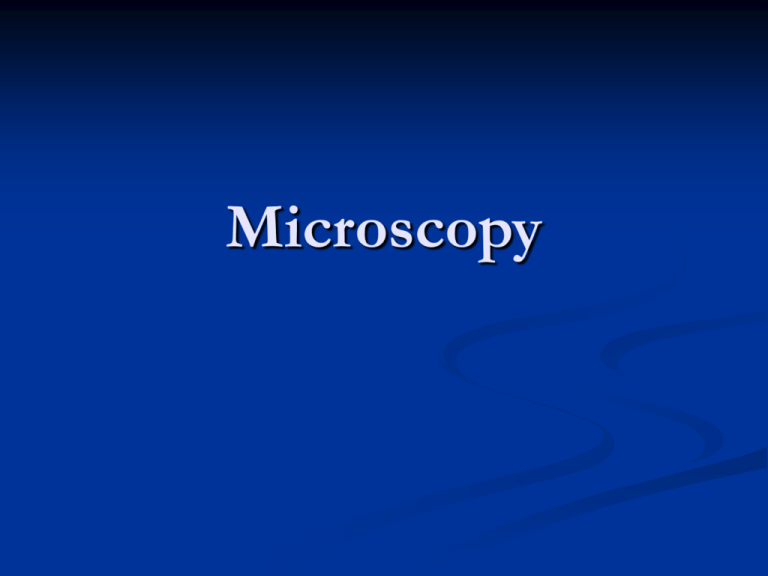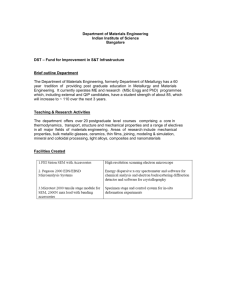3 Microscopy
advertisement

Microscopy UNITS OF MEASUREMENT 1mm = 1000µm 1µm = 10-3mm (convert mm to µm by multiplying by 1000 = 3 zeros) 1nm = 10-6mm (convert nm to mm by dividing by 1000000 = six zeros) Bacteria are about 1µm or smaller Viruses are about 1nm 1000nm = 1µm 1000 viruses can fit into one bacterium 0.001µm = 1 nm Bacteria are so small, they are measured in µm. Viruses are even smaller, so they are measured in nm. VOCABULARY Immersion oil: keeps light from bending and allows lens to be refracted. Resolution: ability of two lenses to distinguish two points. Parfocal: focused in all lenses. Depth of field: how much of the background is in focus at the same time that the foreground is in focus. Refractive Index: a measure of the light-bending ability of a medium Numerical aperture: numerical aperture increases as depth of field decreases. Resolution power: limits the useful magnification of the microscope resolving power. RESOLUTION The ability of the lenses to distinguish two points. RESOLVING POWER The distance between two closely adjacent objects where the objects still appear separate and distinct. The shorter the distance (the smaller the number), the better the resolving power (the sharper the image). RESOLVING POWER To calculate the resolving power (to see how close two objects can be so you can still see them): D = distance (smaller number is better) 0.61 = a constant number, does not change NAobj = numerical aperture of the objective (larger number causes D to decrease, which is better) λ = (lambda): the wavelength (nm) of the light going through the microscope. Convert nm to mm by dividing by 1000000 (six zeros) D = 0.61 λ / NAobj Resolving Power 2 objects resolved 2 objects not resolved Same 2 objects resolved with better optical instrument Resolving power limits for several optical instruments: Optical Instrument Human eye Light microscope Scanning electron microscope (SEM) Transmission electron microscope (TEM) Resolving Power 0.2 millimeters (mm) 0.25 micrometers (µm) 5-10 nanometers (nm) 0.5 nanometers (nm) PRISM This is a triangular device that breaks up light into its various wavelengths so you can see all the colors of the rainbow (the visible spectrum). The visible spectrum of colors starts with violet (350nm), and goes on to indigo, blue, green (550nm), yellow, orange, red (700nm). Sample Problem When we want to observe the color green (550nm) under an oil-immersion objective lens of a microscope, where the NAobj is 1.25, the resolution is as follows: D = (0.61)(0.000550) / 1.25 D = 0.0002684 mm convert this to microns (µm) by multiplying by 1000 D = 0.27 µm Sample Problem The NAobj for the high-dry (400x) lens is 0.65 What is the resolving power (D) of this objective when viewing a wavelength of 550nm? D = 0.61 λ / NAobj D = (0.61)(0.000550) / 0.65 D = 5.1615mm D = 0.52µm Conclusions Therefore, we can see an organism such as E. coli, which is 2µm long and 1µm wide because it is larger than the resolving power. However, we could not see Haemophilus influenza, which is 0.2µm long because it is smaller than our resolving power. Therefore, the resolving power limits the useful magnification of the microscope. Resolution determines the magnification. REFRACTION Refraction is the bending of light caused by the surrounding medium. N = Refraction Index of the medium surrounding the lens Air: N= 1 Glass: N = 1.5 Immersion Oil: N = 1.51 (about the same as glass) TYPES OF MICROSCOPES SIMPLE MICROSCOPE: Has only one lens, like an ocular (eyepiece) COMPOUND MICROSCOPE: More than one lens, like an ocular and an objective. An example is the Brightfield microscope. There are two main types of compound microscopes: Light Microscopes and Electron Microscopes. SIMPLE MICROSCOPE COMPOUND MICROSCOPE: One Eyepiece COMPOUND MICROSCOPE: Two Eyepieces Types of Compound Microscopes Dissecting Brightfield Darkfield Phase-contrast Differential Interference contrast Fluorescence Dissecting Microscope BRIGHTFIELD ILLUMINATION: No Stain BRIGHTFIELD ILLUMINATION: With Stain DARKFIELD ILLUMINATION DARKFIELD ILLUMINATION Brightfield vs Darkfield PHASE CONTRAST MICROSCOPY DIFFERENTIAL INTERFERENCE CONTRAST DIFFERENTIAL INTERFERENCE CONTRAST DIFFERENTIAL INTERFERENCE CONTRAST Fluorescence Microscopy Uses UV light. Fluorescent substances absorb UV light and emit visible light. Cells may be stained with fluorescent dyes (fluorochromes). Figure 3.6b FLUORESCENCE MICROSCOPY FLUORESCENCE MICROSCOPY Transmission Electron Microscope Transmission Electron Microscope Transmission Electron Microscope: Inside of a Plant Cell Scanning Electron Microscope Scanning Electron Microscope: Flea Scanning Electron Microscope: Pollen Scanning Probe Microscope: Red Blood Cells Scanning Probe Microscope: Chromosomes COMPARISON OF MICROSCOPES BRIGHTFIELD Dark objects are visible against a bright background. Light reflected off the specimen does not enter the objective lens Not for looking at live cells Maximum resolution is 0.2µm and maximum magnification is 2000x Stains are used on specimens DARKFIELD Light objects are visible against dark background Used for live cells, cilia, flagella Especially good for spirochetes Uses special condenser with an opaque disc that eliminates all light in the center PHASECONTRAST No staying required Accentuates diffraction of the light that passes through a specimen Good for live cells; good contrast Most sensitive; cilia shows up Not three-dimensional DIFFERENTIAL Uses two beams of light INTERFERENCE Shows three dimensions CONTRAST Has a prism to get different colors Good for live cells (unstained) Best resolution COMPARISON OF MICROSCOPES FLUORESCENCE Uses ultraviolet light Stained cells with fluorescent dye; energizes electrons and creates visible light No live cells Quick diagnosis of TB and syphilis TRANSMISSION ELECTRON Get flat images Have vacuum pumps to allow electrons to float better Stain with heavy metal salts Shows sections of cell, revealing organelles Requires an ultramicrotome Best resolution of all microscopes SCANNING ELECTRON Surface view only Needs a vacuum No live cells Three-dimensional view SCANNING PROBE Physical probe scans the specimen Raster scan: image is cut up into pixels and transmitted to computer Not limited by diffraction Slower in acquiring images Maximum image size is smaller





